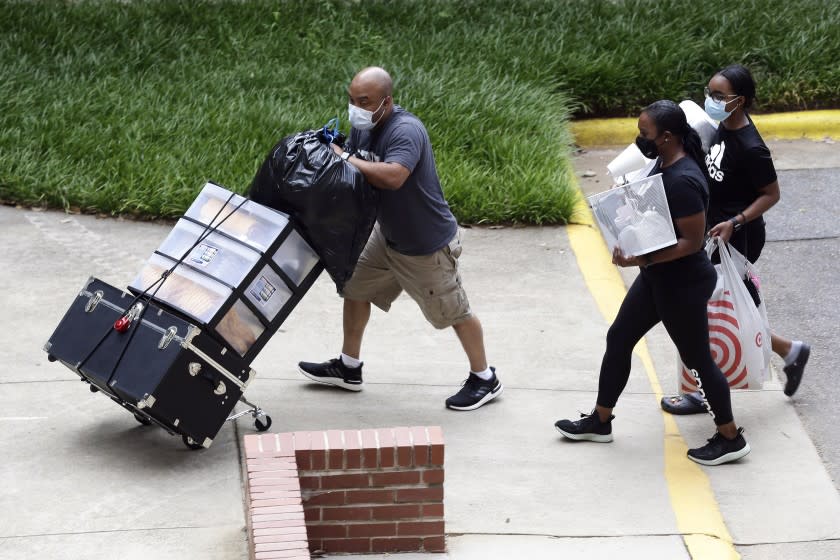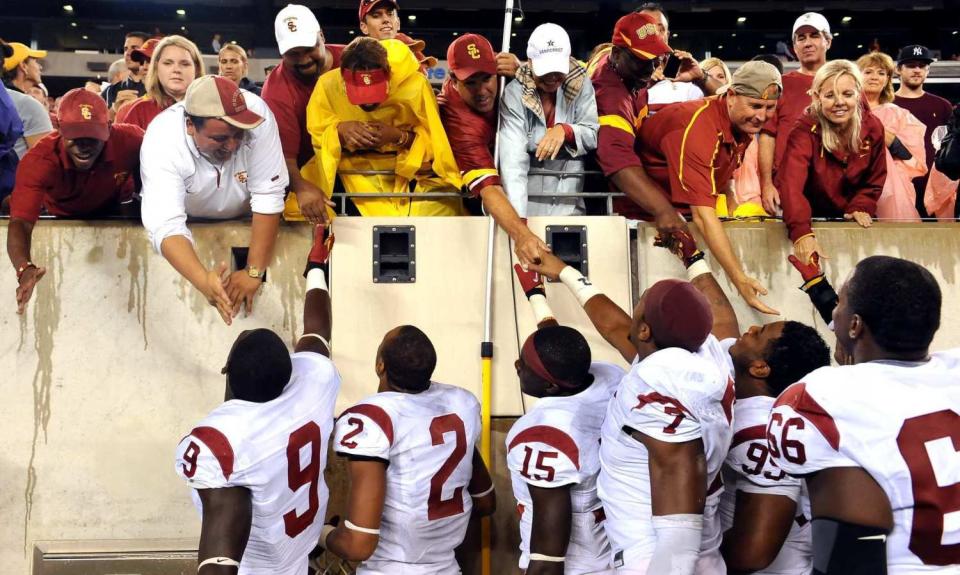'I can't teach when I'm dead.' Professors fear COVID-19 as college campuses open

When masked students walk back into his Northern Arizona University lab room at the end of the month, Tad Theimer will face them from behind a Plexiglas face shield while holding an infrared thermometer to their foreheads. As they examine bat skulls under microscopes, the biology professor will open windows and doors, hoping to drive out exhaled aerosols that could spread the coronavirus.
But as one of hundreds of professors who will be back on campus along with 20,000 students in one of the states worst hit by the pandemic, Theimer is also torn on whether to enter his classroom at all.
"I want to teach and it's best done in person," said Theimer, 62, who has been a professor on the Flagstaff campus for two decades. "I want businesses, which need our students, to survive in town. But if I see people not following health protocols at the university, I'm going remote and I'm not seeking any permission. They can fire me if they don't like it."
Campuses are taking on a patchwork of safety measures and shifting reopening plans this month as millions of students return to colleges and universities. Some, like Northern Arizona University, have already opened for a trial run of online classes before students show up in person. Others, like Johns Hopkins University in Maryland and Princeton University in New Jersey, have at the last minute nixed plans for reopening to opt for fully online fall semesters. Many California colleges and universities will be online only, with largely empty lecture halls, while the majority of schools in the nation plan to offer a hybrid of the options.
Absent federal guidance, many of the decisions result from growing pressure from professors like Theimer, who recently went public with a letter to his university president demanding that students be disinvited from campus. At several universities, including large public schools in Texas, Florida and North Carolina, teachers have resisted administrations that push to pack the classrooms and dorms that produce tuition and housing revenues. Many have voiced opposition through unions or faculty associations.

Students have joined too, like the dozens at the University of Georgia who joined faculty to stage a "die-in" in front of the president's office this week with signs that said "R.I.P. campus safety" and "I can’t teach when I’m dead." The campus requires first-year students to live in dorms for its Aug. 20 kickoff to the fall semester, which will take place partially on campus.
It was a similar story at the City Colleges of Chicago, where faculty followed last week's reopening by threatening to strike if they don't see safety improvements.
"The whole situation is unprecedented," said Irene Mulvey, a math professor at Fairfield University in Connecticut and president of the American Assn. of University Professors, a teachers' union with hundreds of college chapters. "Professors know best what's happening on the ground and they are in many cases pushing to have a say. And in the case of some university administrations, there seems to be a kind of magical thinking that people will behave perfectly in following every health measure and precaution during openings."
Colleges have tried to reassure professors and students by staggering dorm move-in dates, painting arrows and social distancing dots in hallways, limiting classroom sizes, enforcing mask mandates and installing hand sanitizing stations across campuses. They've designated quarantine housing and some, like UC Berkeley, have the limited number of students living on campus take a coronavirus test within a day of arrival in addition to regularly scheduled tests teach month.
But with the average American campus having more than 6,000 undergraduates, many professors have said the safety precautions will be too hard to enforce, especially at schools where most students live in dorms and off-campus apartments.
At the University of North Carolina at Chapel Hill, dozens of tenured professors recently published a letter in the Charlotte Observer pleading with students to stay home this fall.
"We want to be in the classroom teaching you," it said. "However, we cannot in good conscience perform that role on campus this semester."
Classes began Monday at the Chapel Hill campus. Dorms will be largely be occupied, but many students will live on campus without stepping in classrooms. Administrators expect just one-third of the usual 19,000 undergraduates to attend instruction in person.
The university, which maintains a website with coronavirus data, said it found 10 students and one employee on campus to be infected in the week ending Aug. 9.
Michael Palm, a communications professor who signed the letter, thinks it will only get worse. "It is abundantly clear that it's impossible to open a college campus the size of UNC-Chapel Hill with any semblance of safety," said Palm, who has been staying with family in Chicago since the pandemic hit and plans to teach his two graduate seminars online.
Even with quads open, the fall semester will feel eerily quiet at many of the largest universities that will miss out on the crowds and millions of dollars generated from popular sports teams and undergraduate residential fees as fans and students stay away.

The Big Ten Conference, which includes the University of Michigan and University of Wisconsin-Madison along with 12 other major football teams, said on Tuesday that it was cancelling its fall season. The Pac-12 Conference followed in calling off its plans for this year, joining the Mountain West and Mid-American conferences.
At the University of Texas at Austin, the state's flagship campus, only about 5% of the nearly 52,000 students have opted to take classes fully in-person.
The Texas Faculty Assn. sent a letter to Gov. Greg Abbott, a Republican, earlier this month urging him to delay in-person classes until September to give colleges and universities — both public and private — more time to reopen safely.
“What I’m hearing is a wide range of plans. Some are allowing faculty to decide: Do you want to teach hybrid, in person or remote? Others are saying no, you don’t get to decide, you were hired to teach in-person,” said Patricia Heintzelman, the association’s president and an instructor at Lamar University in Beaumont, a public school with an enrollment of more than 14,000 students that is set to open Tuesday.
The association, which includes about 500 faculty statewide, also asked the governor to make Texas colleges enforce mask requirements. Otherwise, Heintzelman said, “How are we going to get [students] to follow the guidelines?”
Heintzelman, 66, has a daughter at home with a brain tumor. She calls herself “one of the fortunate” because she is allowed to teach remotely. She said a co-worker told her last week he’s retiring early rather than returning to teach in person.
At Texas A&M University-San Antonio, the Faculty Senate voted late last month that when classes resume next Thursday, they should be taught online, for the safety of professors, students and the surrounding community, which is largely Latino, low-income, and more at risk for COVID-19. Earlier this year, two students at the school of 6,500 died after contracting the virus.
“I love being in the classroom. I miss it desperately. But we have to recognize this is a public health crisis,” said James Finley, an associate English professor and Faculty Senate member.
“The system is pressuring us to have face-to-face classes,” said Finley, who noted that it’s hard for junior faculty to refuse since they have less job security than those with tenure.
Not all professors are resisting the call to return.
At Whitworth University, a small, liberal arts institution in Spokane, Wash., English professor Fred Johnson said he's comfortable with plans to teach in person and to offer some breakout sessions online. At 45, he's in good health, and students in his two courses capped at 15 people each will be required to mask up.
A private Christian school near the Idaho state line, the college serves 3,000 students, and expects most of the usual 1,200 students who reside on campus to live there this academic year.
Administrators say they have spent months designing systems to enable dorm living and classroom instruction, going so far as to establish an in-house contact tracing team to track sources of infection. As is the policy on many campuses nationwide, students will be expected to socialize only with roommates, residents of the floors where they live and small groups of friends identified at the beginning of the semester.
It'll be more straightforward, though, to enforce safety rules in the classroom. Students in some courses will alternate between in-person and online attendance. They will face forward in distanced, assigned seating, and attendance will be taken. The university has designated housing for quarantine and isolation. Whitworth has contracted with a lab that guarantees test results within 48 hours for anyone experiencing symptoms consistent with the coronavirus.
Those are among the reasons that Johnson feels it's safe for him to return. Among faculty overall, he said, “different people have different levels of comfort” with face-to-face instruction. He said professors at higher risk due to age or underlying health conditions are choosing to teach online.
Randy Michaelis, the Whitworth interim dean for continuing studies and graduate admission, said that a majority of professors may be anxious about in-person instruction during the pandemic, but that they “are willing to roll up their sleeves and give it a try."
Still, with cases growing recently in Spokane County, Michaelis admitted that outbreaks on campus were possible. This week, the top county health director said an outbreak of cases in K-12 schools was "very likely," and pushed for all schools to close their doors. At Whitworth, the college has prepared a detailed plan for online learning in the case of a surge.
Seven hours southwest, in the city of Eugene, the University of Oregon is also proceeding cautiously.
The state school of 19,000 undergraduates plans both in-person and online courses this semester. But administrators say they’re closely monitoring a rise in COVID-19 cases in Oregon and could end up cutting back classroom instruction.
"They want to offer in-person classes for the fall because we know very clearly that students want in-person classes,” said Melissa Graboyes, a professor of African and medical history. But she opposes reopening the campus and has asked to teach online.
In a survey she conducted earlier this summer of of 2,300 students, faculty and staff, 65% of students said returning to campus for classes was the right decision while just 34% of faculty members said it was wise.
Journalism professor Peter Laufer said the debate among faculty is constant with the approach of fall quarter on Sept. 29. He expects that by then a spike in national caseloads will have forced the University of Oregon and many other universities to scale back dramatically.
“In the face of the ghastly numbers we’re seeing in this country," he said, "it’s hard for me to imagine that universities will proceed with a schedule of on-site, in-person classroom teaching."
Kaleem reported from Los Angeles, Hennessy-Fiske from Houston and Read from Seattle.


